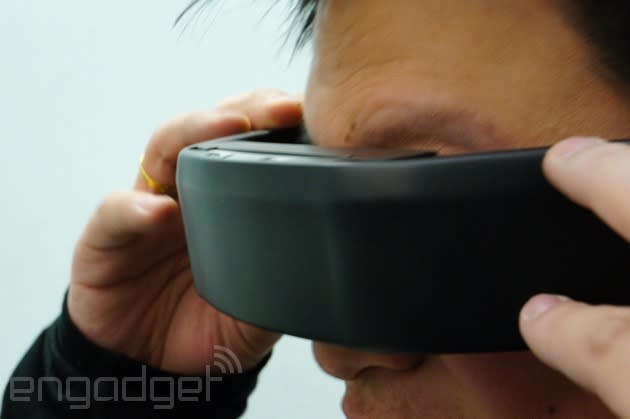Avegant Glyph personal theater headset gets closer to market

When we first saw the Avegant Glyph earlier this year, it was still in its alpha stage. The home theater headset that literally looks like a pair of chunky headphones for your eyes did impress us with its stunning visuals, but the overall thing was still very rough around the edges as far as fit and components go. Now, after a successful Kickstarter campaign and a move to California, Avegant is confident that it's homed in on the last few adjustments it needs to get the finished product out the door, and I was able to get a sneak peek at just what those updates are.
In a series of demos set inside Avegant's brand-new offices in Redwood City, California, I tried out both the alpha version of the Glyph that was shown in January and its new development prototype. As a brief reminder, the Glyph works by projecting images directly to your eyes with an array of 2 million micromirrors. Allan Evans, Avegant's CTO, tells us that the mirrors essentially create a light field that matches "long-term vision." "The shape of the light coming into your eye is the same as the light from far away, like when you're sitting in front of a movie theater," explains Evans. "The result is a visual that's sharper and clearer than a traditional LCD."

From my initial impressions with the Glyph, I can certainly attest to that. I watched brief video clips and played a couple of games with both the alpha and the latest prototype. Images were amazingly crisp, which is especially surprising considering I had to wear the Glyph without my glasses. The beauty of the Glyph, as Chief Strategy Office Ed Tang tells me, is that you can adjust the focus of each lens, so even those with poor eyesight should be able to use it without corrective eyewear. Image quality was slightly better on the recent development prototype due to improved optics, though not by much -- the alpha version was quite good already. Audio quality was pretty good too; Evans says they're aiming for theater-quality sound.
What really improved, however, was the overall ergonomics. Avegant worked to enhance not just the fit of the headset, but also the way you adjusted the interpupillary distance (IPD) -- the space between your eyes -- of each lens. The adjustment controls are now on the bottom for easier reach and they also feel a little more accurate when we tried to dial ours in. Further, the alpha version had a lot of external components for video processing, while the development prototype has all of its parts built right into the headset. Therefore, only one MHL/HDMI cable is needed to hook the headset up to the source. "The electronics have matured to the point that it's now portable," says Tang, adding that it has a built-in battery and can be hooked up to a smartphone.
I should add that it's important to bear in mind that the Glyph is not like the Oculus Rift; there's no full immersion here. You'll still see some empty space surrounding the picture, like you would in a movie theater. I did get a demo of a 360-degree shot video while wearing the Glyph, however, and that did provide me with an immersive feeling due to a head-tracking system; I could turn around to view what was going on around me. Avegant also showed off a cool demo where it hooked up a Paralinx wireless HDMI dongle to a Parrot AR drone and managed to transmit the video from the drone's camera to the headset so I could get a drone's-eye view of the world. Additionally, Tang didn't rule out the VR possibilities for the Glyph completely; the company just wants to focus on personal entertainment for now.
Still, as good as the development prototype is, it's nowhere close to final production. It still took me several minutes to adjust the IPD, and even then I wasn't 100 percent satisfied with how comfortable it was. It also felt too heavy for my liking. Avegant says it's definitely still working on fit issues, as well as trying to slim the whole thing down.
While I'm not at liberty to reveal too many details about the final product, I did get a brief glimpse at what Avegant hopes the finished Glyph will look like, and I have to say that if Avegant even comes close to that, it would improve the experience significantly. As for when we'll see it? Well, if all things go according to plan, probably pretty darn soon.






